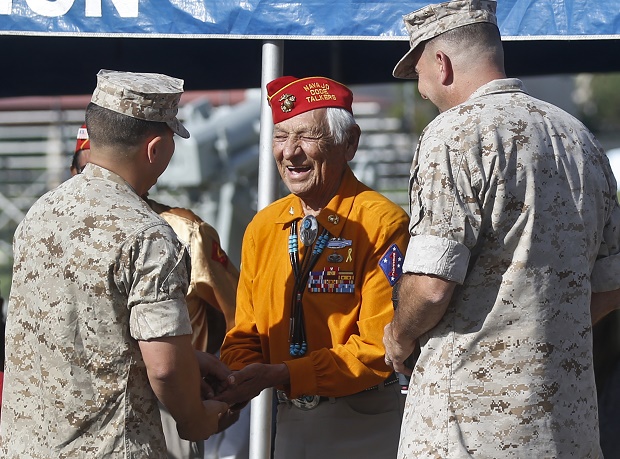Navajo code talker recalls WWII role in tricking Japanese

This Sept. 28, 2015 file photo former United States Marine and Navajo Code Talker Roy Hawthorne, center, talks with Marines including Major Gen. Daniel O’Donohue, right, at a ceremony honoring the Navajo Code Talkers and their contributions to the American war effort in World War II at Camp Pendleton, Calif. Hawthorne recalls his time served during World War II with pride, effortlessly sharing his native Navajo language as he shows off how he used codes to trick the Japanese. AP File Photo
WINDOW ROCK, Arizona, United States—Roy Hawthorne recalls his time served during World War II with pride, effortlessly sharing his native Navajo language as he shows off how he used codes to trick the Japanese.
Hawthorne recently traveled to Camp Pendleton near San Diego for the first time since he trained there along with fellow Navajos before they embarked on their fabled war mission in the 1940s.
The trip to California rekindled memories for the 89-year-old Marine about the effort that remains an important part of U.S. military history as the nation paused to commemorate Veterans Day.
“It gave us a sense of pride but we never thought of ourselves as heroes,” Hawthorne said during a recent interview in Window Rock, Arizona, the capital of the Navajo Nation. “We were just young Navajo men, mostly teenagers, that were looking for adventure … And we were a group that was willing to place our lives in places of danger to protect our country.”
Hawthorne served as a Navajo code talker with the U.S. Marine Corps from 1943 to 1945, hopping from island to island across the South Pacific as U.S. troops fought their way toward Japan.
Article continues after this advertisementHe was among an estimated several hundred code talkers who joined the war effort to help stymie the Japanese by using Navajo words and letters transmitted over radios instead of traditional codes that the enemy continued to crack.
Article continues after this advertisementThe Marine Corps Navajo Code Talker Program began in September 1942. Commanders believed that since Navajo was an unwritten language and virtually undecipherable to those who didn’t speak it, the language could be used to devise a code the Japanese couldn’t crack.
For example, the code talkers would use the word “hummingbird” in Navajo to describe reconnaissance airplanes, he said.
“Well, it flies at night. It’s quiet, doesn’t carry any armament, and we said, ‘Well, that’s a hummingbird,'” Hawthorne recalled.
Officials say the codes worked. They credit the Navajo for playing a hugely vital role in combat along with some other tribes that used their native languages during wartime.
“We didn’t win the war by ourselves, but we were very instrumental in the war’s favorable outcome for our country,” Hawthorne said. “So we consider our language to be a precious commodity today.”
RELATED STORIES
Private: Filipino WWII veterans fight never-ending battle for equity